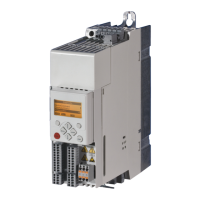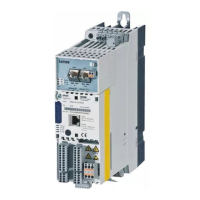Firmware ≤ 05.00 - DMS 4.2 EN - 02/2010 L 419
8400 HighLine | Parameter setting & configuration
Basic drive functions (MCK)
Positioning
Speed (C01302/1...15)
Maximum speed at which the target is to be approached.
• Depending on the profile parameters of position, acceleration and deceleration , it is possible that
the drive will not even reach the maximum speed. In this case, the graphic representation will be a
trapezium instead of a triangle:
n Acceleration
o Travelling speed (is not reached in this case)
p Deceleration
q Target position (or traversing distance)
Acceleration (C01303/1...15
)
Stipulation of the change in speed at which maximum acceleration is to take place.
• Two types of acceleration are distinguished:
–Constant acceleration: the speed increases linearly.
–Linearly increasing acceleration: the speed increases in an S shape.
n Constant acceleration
o Linearly increasing acceleration
Deceleration (C01304/1...15
)
Stipulation of the change in speed at which maximum deceleration to a standstill is to take place.
S-ramp time (C01305/1...15
)
Due to stipulation of an S-ramp time for a profile, the profile is executed with S-shaped ramps, i.e.
acceleration and braking processes are initiated smoothly in order to reduce jerk and thus the stress on
the drive components.
• The acceleration/deceleration stipulated in the profile is not achieved until after the specified S-
ramp time.
• This kind of acceleration/deceleration is needed for sensitive machine parts with a certain amount
of play.
• The unavoidable consequence of the slower increase in acceleration in the case of the S profile is that
the positioning time is longer compared to the L profile, which is more efficient in terms of time.
S-ramp time for jerk limitation
( 422)
n Without jerk limitation (L profile)
o With jerk limitation (S profile)
Symbol Profile parameter
B
v
pos
v [m/s]
t [s]
C
v
pos
v
pos
v [m/s]
v [m/s]
t [s]
t [s]
D
E
a
v [m/s]
t [s]
t [s]
efesotomasyon.com - Lenze

